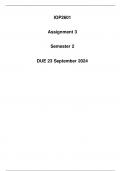Exam (elaborations)
IOP2601 Assignment 3 Semester 2 Due 23 September 2024
- Institution
- University Of South Africa
UESTION 1 [5] 1.1 Indicate whether the following statements are True or False. a) A non-directional hypothesis is used when there is no prior theoretical basis for predicting the specific direction of the effect or relationship between variables. (1) b) In a study testing a directional hypoth...
[Show more]



